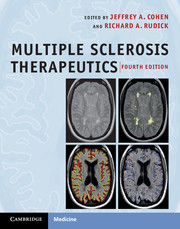Crossref Citations
This Book has been
cited by the following publications. This list is generated based on data provided by Crossref.
Correale, Jorge
Ysrraelit, María C.
and
Fiol, Marcela P.
2012.
Benign Multiple Sclerosis: Does it exist?.
Current Neurology and Neuroscience Reports,
Vol. 12,
Issue. 5,
p.
601.
Fujihara, Kazuo
2013.
11. Multiple Sclerosis (MS) and Neuromyelitis Optica (NMO).
Nihon Naika Gakkai Zasshi,
Vol. 102,
Issue. 9,
p.
2426.
Hyland, Megan H.
and
Cohen, Jeffrey A.
2014.
Multiple Sclerosis and CNS Inflammatory Disorders.
p.
57.
Correale, Jorge
and
Farez, Mauricio F.
2015.
The Role of Astrocytes in Multiple Sclerosis Progression.
Frontiers in Neurology,
Vol. 6,
Issue. ,
Hang, Yaming
Hu, Xiao
Zhang, Jie
Liu, Shifang
Deykin, Aaron
and
Nestorov, Ivan
2016.
Analysis of peginterferon β-1a exposure and Gd-enhanced lesion or T2 lesion response in relapsing-remitting multiple sclerosis patients.
Journal of Pharmacokinetics and Pharmacodynamics,
Vol. 43,
Issue. 4,
p.
371.
Correale, Jorge
Gaitán, María I.
Ysrraelit, María C.
and
Fiol, Marcela P.
2016.
Progressive multiple sclerosis: from pathogenic mechanisms to treatment.
Brain,
p.
aww258.
Asendorf, Thomas
Henderson, Robin
Schmidli, Heinz
and
Friede, Tim
2019.
Modelling and sample size reestimation for longitudinal count data with incomplete follow up.
Statistical Methods in Medical Research,
Vol. 28,
Issue. 1,
p.
117.
Mütze, Tobias
Glimm, Ekkehard
Schmidli, Heinz
and
Friede, Tim
2019.
Group sequential designs for negative binomial outcomes.
Statistical Methods in Medical Research,
Vol. 28,
Issue. 8,
p.
2326.
Lioudyno, Victoria
Abdurasulova, Irina
Negoreeva, Irina
Stoliarov, Igor
Kudriavtsev, Igor
Serebryakova, Maria
Klimenko, Victor
and
Lioudyno, Maria
2021.
A common genetic variant rs2821557 in KCNA3 is linked to the severity of multiple sclerosis.
Journal of Neuroscience Research,
Vol. 99,
Issue. 1,
p.
200.
Karim, Mohammad Ehsanul
Pellegrini, Fabio
Platt, Robert W
Simoneau, Gabrielle
Rouette, Julie
and
de Moor, Carl
2022.
The use and quality of reporting of propensity score methods in multiple sclerosis literature: A review.
Multiple Sclerosis Journal,
Vol. 28,
Issue. 9,
p.
1317.





